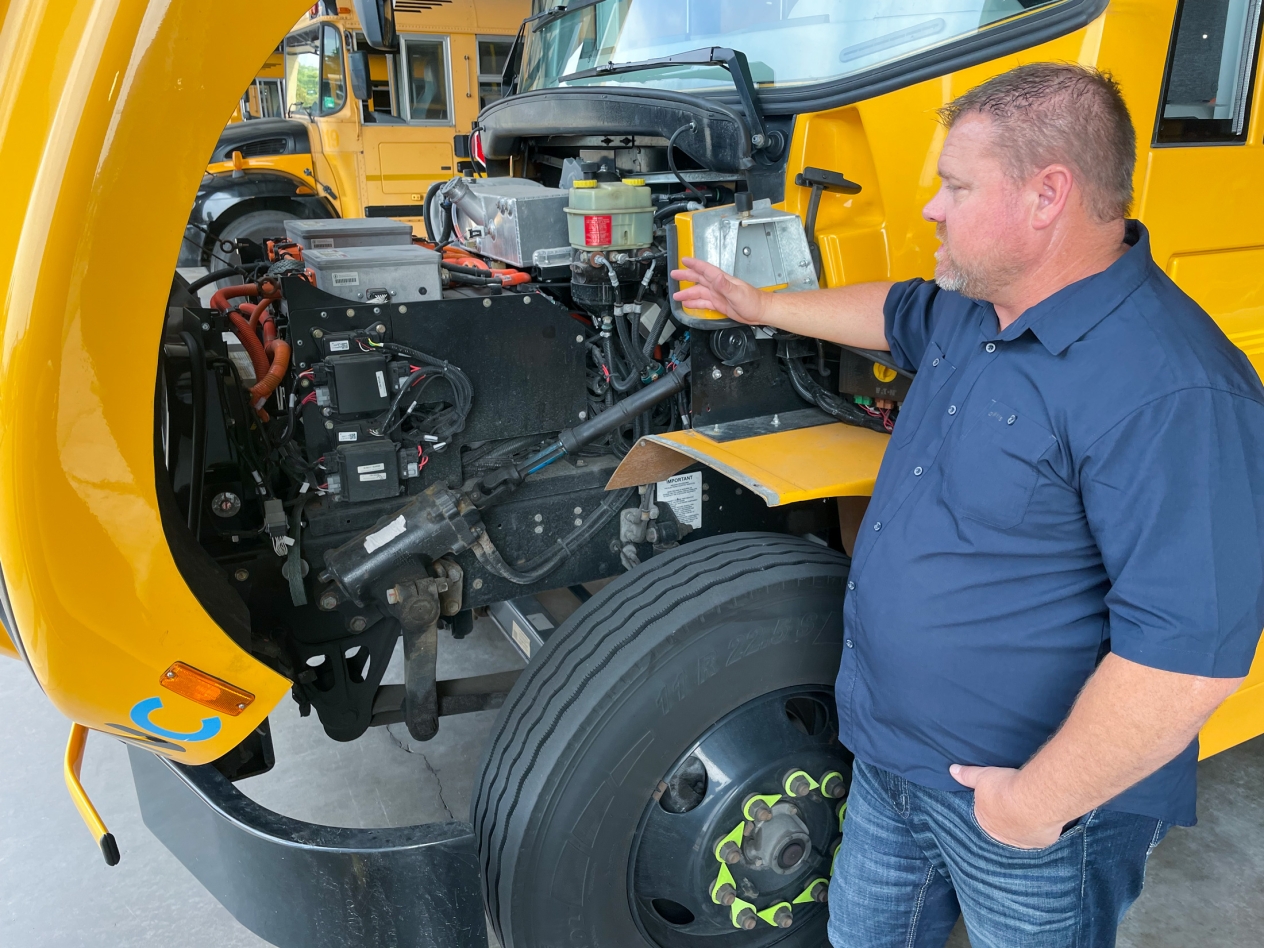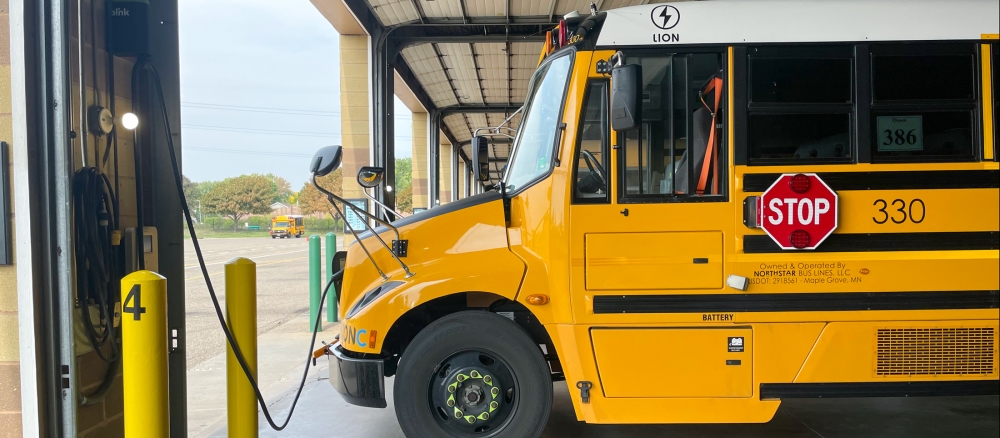MPCA-administered grants aim to make the electric buses more affordable for Minnesota schools
Out in the garage of the Northstar Bus Lines headquarters in Maple Grove, three buses sit parked in a row. They appear no different from the many other buses awaiting their afternoon rounds in the Northstar parking lot: big, Twinkie-shaped, adorned with yellow and red lights on their brows and fitted with a swing-out stop sign.
Yet under that high-visibility yellow paint lies one of the biggest changes to school buses in decades: a full-electric drivetrain, made affordable thanks to a grant from the Minnesota Pollution Control Agency.
“We’re still learning how to make it work for us, and we’re working through the challenges, but it’s been a fun project so far,” says Nick Martini, the senior vice president of operations at Northstar Bus Lines.
Northstar Bus Lines operates about 300 buses out of a couple locations in the northwest Twin Cities metro area, serving about 10 school districts and various charter schools. It’s been around for more than 50 years and has likely operated some of the same buses seen in the framed brochures and advertisements from the 1960s and 1970s hanging in its lobby.
Just as important as its history, though, is its future, which is why the company applied for the first round of grants from the MPCA to help Minnesota bus operators purchase electric school buses. Of the eight electric school buses that have already gone to various school districts and busing companies across the state, three went to Northstar.
“We want to know as much as we can about the technology now without bearing the full financial burden of buying the buses,” Martini says.
According to Brian Timerson, who oversees that grant program for the MPCA, this program is one of many that fit into a longer-term strategy to address climate change and reduce greenhouse gases (GHG) in Minnesota. The transportation sector in general represents the largest source of emissions in the state, and replacing diesel buses with electrics reduces GHG emissions by anywhere from 105 to 175 tons per vehicle, according to MPCA research.
A stumbling block to switching
But electric school buses are expensive. With chargers, they can cost up to $400,000, or about four times the cost of a new diesel school bus. Timerson says it’s hard for school districts to justify that expense, and as a result, adoption of electric school buses has been slow: The MPCA knows of only 10 electric school buses currently in operation in Minnesota. The 15-year lifespan of a typical school bus doesn’t help, either; buying buses is a significant investment, so school districts and bus operators tend to keep their older buses in service as long as possible.
That’s a problem not just for the state’s goal of reducing GHG emissions but also for the health of the communities in which those buses operate. Diesel-powered buses emit fine particulate matter, among other pollutants, and children tend to get the brunt of exposure to those pollutants, whether it’s from the exhaust seeping into the cabins of the buses, rushing into the buses’ open windows, or pooling around the idling buses in school drop-off and pickup lines. Those pollutants can contribute to or exacerbate health problems including asthma attacks, reduced lung function, and inflammation.
With funding that came out of the $14.7 billion settlement that Volkswagen agreed to pay in 2016 after it was caught cheating on diesel emissions, however, states across the country suddenly had a new tool to leverage to convince more school districts and bus operators to make that switch.
Minnesota received $47 million out of that settlement to use for clean transportation projects through 2027, with one of those projects distributing more than $2 million in cost-match grants to help school districts and bus operators purchase electric buses in 2020. The grant provides up to 85% of the purchase price of a new electric school bus and requires the school district to cut the frame and destroy the engine block of the diesel bus it’s replacing. The Osseo Area School District, which Northstar Bus Lines services, was able to get a grant for three buses and charging stations, which all went into service in the fall and winter of 2021.
Practical benefits to electrics
Those three Lion Electric buses all conform to the same safety guidelines as regular diesel buses, seat the same number of students as diesel buses, and ply similar routes as diesel buses, Martini says. They charge overnight, make their rounds in the morning, then go back on the charger during the mid-day break before going out for afternoon rounds.
Their range — about 125 miles — might not match that of the newest and sleekest electric cars, but Martini says it’s enough for the buses’ typical use on routes in the Osseo district, even in the winter when colder temperatures cause the range to decrease by 10-15%.
“Just like we wouldn’t send a bus out with half a tank of fuel, we wouldn’t sent one of these out with half a charge of battery,” he says. “School buses are really poised to make the switch to electric successfully with their stop-and-go driving and the ability to charge during the mid-day break.”

Martini also noted practical benefits to operating the electric buses, from the savings in fuel costs — about a third less than diesels — to the reduced maintenance time to the improved weight distribution that helps buses avoid getting stuck in winter slush and snow. Lion Electric’s buses are even swathed in composite body panels, which reduces weight, increases range, and gives the buses a longer service life in salty-road climates like Minnesota.
The near-silence of the buses also appeals to drivers, who no longer have to listen for rowdiness at the back of the bus amid the din of exhaust noise reverberating in the cabin.
In fact, Martini says that schools may have to figure out how to educate students and parents to be aware of the quiet buses as they approach.
“They’re equipped with an alarm that’s supposed to sound when the buses go below 10 miles per hour,” he says. “But people aren’t used to it yet.”
Priming the pump
Martini can even envision other uses for the electric buses that haven’t yet been explored, such as grid storage during the summers, when the buses aren’t in use and demand for electricity storage is high, or integrating them into STEM classes and programs. But that all depends on wider adoption of the technology, which in turn depends on electric buses becoming competitive in price with diesel buses.
“I think those costs will come down,” he says. “It’s no different than any other new technology like CD players or TVs.”
In the meantime, the MPCA is doing what it can with the remaining Volkswagen settlement funds to help Minnesota schools afford electric school buses and replace their older diesels. Another round of grants like those that helped North Star buy its three buses will be released in the coming months.
“We won’t be able to replace all of the state’s school buses,” Timerson says. “But we’re trying to force the cost down with what we’re doing. We’re priming the pump so that more schools can adopt them.”

